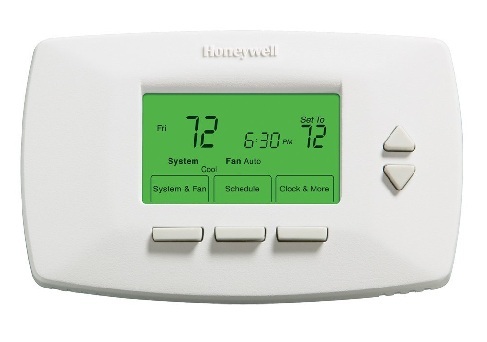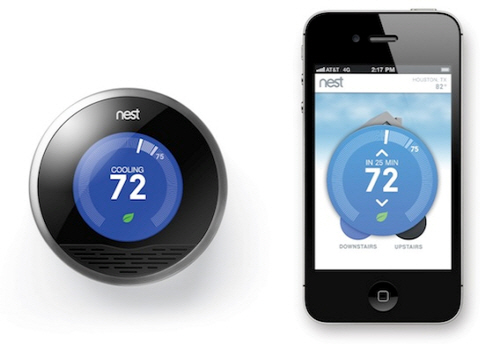Late yesterday afternoon Google and Nest announced that Google will be acquiring Nest for $3.2 billion. Now that s a good bit of change, and we detailed what it will all likely mean in our analysis of the deal. In that analysis we brought up the venerable name of Honeywell as the incumbent in the thermostat space – something that is true for both the consumer and business market segments. But we jest in using the word “venerable” here. Certainly from Nest’s perspective there isn’t much venerable about Honeywell, either in terms of its business status nor – especially – in terms of what it has spent roughly 70 years delivering to the market on the home thermostat front – sturdy, unspectacular, exceedingly boring, and a deliberate and, for Nest, disquieting lack of any innovative what so ever.
There is no doubt that Honeywell is an old school vendor. Its products typically underscore this – lots of reliability, very little excitement, they just work as they are supposed to…but, they follow a formula of “if it ain’t broke there sure is no need to fix it.” What this means of course is that Honeywell’s thermostats, despite the occasional attempt at a refresh – which means nothing more than, in most cases, adding say, a monochrome LCD screen to the same underlying thermostat – remain as old school as they can possibly be.

In other words, Honeywell doesn’t have much in hand really to compete with, but as the 1,600 pound gorilla in the room it doesn’t really need to. Keep the R&D dollars down to almost zero and just keep selling what it has always sold has long been a winning Honeywell strategy. On occasion Honeywell will face some competition and as many of these old school yet still fairly deeply pocketed and fully lawyered-up companies will do, pulls together the lawyers, pulls out some old IP and threatens to run the upstart competitors out of town simply by exhausting them and their limited resources and leaving a scorched earth behind them they can’t recover from.
Are we exaggerating? We don’t think so.
When Nest emerged and its founders – Tony Fadell and Matt Rogers, both former Apple innovators - began to finalize their first Nest Thermostat they suddenly found themselves faced with exactly this scenario. Sitting before them was an infringement letter underpinned with the promise and threat of a full-defended lawsuit by a well-prepared staff of old school attorneys.

For Nest it was instantly clear that Honeywell wasn’t interested in licensing fees or constructive dialog. It was clear that Honeywell wanted Nest entirely out of the thermostat market. Fortunately for Nest Fadell and Rogers came equipped with plenty of experiences in dealing with such tactics from their Apple iPod and iPhone days. Soon enough they brought on board Apple’s former chief patent counsel Richard Lutton Jr. as VP and general counsel and they began to build their defense strategies.
Fadell has been quoted in the past (over on The Verge website) as saying, "They are not trying to get money out of us. They are trying to maintain the status quo…In seven decades, there appears to be little more technological improvement to the flagship Honeywell thermostat than the replacement of a mechanical display with an LCD." It is absolutely and entirely believable.
Also by way of The Verge (a major tip of the hat is warranted!) here are the actual patents that Honeywell is asserting are being infringed, along with Nest’s comments about the patents:
- #7,584,899, which covers a rotating ring around a central display. Nest says this was "implemented years earlier by engineers at Volkswagen," who filed for a European patent.
- #6,975,958, which covers controlling a thermostat through the internet. Nest says this was already covered by now-expired patent #4,657,179, which Honeywell first filed for in 1984 — a patent it did not disclose to the Patent Office.
- #7,476,988, which covers "power-stealing" to charge the thermostat's battery from the control wires. Nest says Honeywell already patented the idea ten years prior in patent #5,736,795 — and once again didn't tell the Patent Office.
- #7,159,790, which covers a rotating selector with an offset rotation axis. You guessed it: Nest says Honeywell filed for exactly the same thing nearly 20 years prior, resulting in patent #4,405,080, a patent Honeywell didn't disclose to the Patent Office.
- #7,634,504, which is Honeywell's wild patent for using natural language prompts to program a thermostat. Nest says this is a retread of patent #5,065,813, which was filed 15 years earlier and not shown to the PTO by Honeywell.
- #7,142,948, which covers displaying the time it'll take to reach a certain temperature. Nest says that was already covered by patent #6,286,764 and #5,767,488 — patents that were again not disclosed to the PTO.
- #7,159,789, which covers a thermostat with a rotatable selector dial partially hidden behind a non-moving cover. At this point you should be ready for this: Nest claims this was already covered by patent #5,224,649, which Honeywell did not disclose to the PTO.
Well, wow – we would not think it possible that this could be real – it strikes us as something we might otherwise find in an over the top business-intrigue novel! But the more we think about it, the more it absolutely fits the Honeywell/old school vendor approach we noted earlier. Honeywell seems anything but venerable! We can picture some sort of cigar chomping execs straight out of a 1950s movie. In fact the movie we are specifically thinking of is Paul Newman’s and Tim Robbin’s 1994 movie, The Hudsucker Proxie – if you don’t know it head on over to Netflix and watch it.
Given the above patent scenario and the very real possibility that Honeywell might very well have been able to keep Nest completely sidelined, we can certainly see a huge sigh of relief coming from Fadell and Rogers now that they will have Google and its massive resources fully behind them. They will simply be able to out-Honeywell Honeywell.
As we noted in our Google-Nest deal analysis, there is certainly the possibility – even given the above patent issues Nest has uncovered – that Honeywell will win the patent lawsuit. But in that case Google may have to shell out a few dollars (and if the judge ends up having a proper sense of humor he or she would set penalties at $1.00) but Nest will still be there competing head on with Honeywell.
Honeywell will remain entrenched - especially where cost is a real issue, but what will happen is that Honeywell will be forced to play catch up with Nest for every other home and that will prove an absolutely impossible task.
For an additional perspective please do scope out the original Verge Nest-Honeywell article.
Edited by
Cassandra Tucker